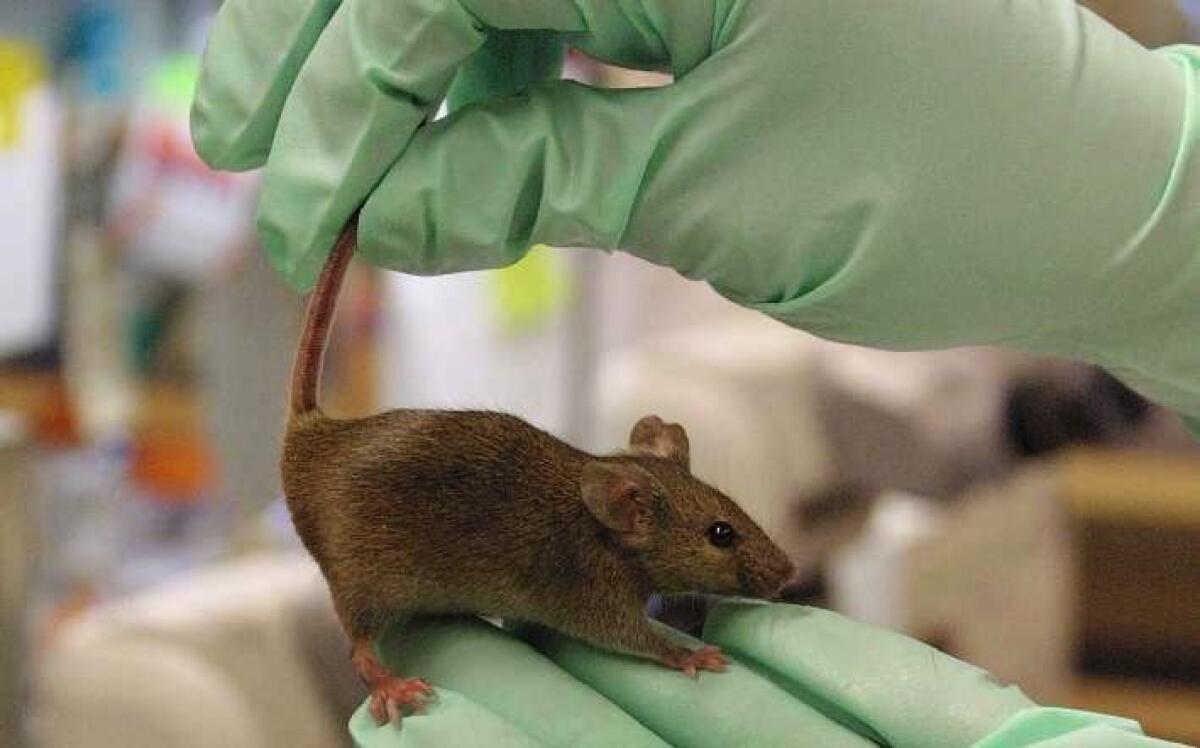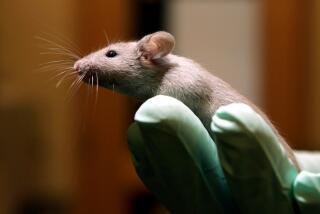Team reportedly grows ‘better quality’ stem cells in live mice

- Share via
Researchers have reprogrammed cells inside living mice -- and have discovered that the pluripotent stem cells created in the process are even more flexible than those derived from embryos or grown in laboratory dishes.
Someday the achievement might help scientists devise ways to treat human disease by directly regenerating tissues within human patients, said Manuel Serrano, an investigator at the Spanish National Cancer Research Center in Madrid and senior author of a study (abstract here) detailing the research, published online Wednesday by the journal Nature.
But that won’t happen immediately, he added during a call with reporters Tuesday.
The pluripotent stem cells are highly flexible and have the potential to develop into nearly any cell type in the body. Researchers hope to take advantage of them to rebuild tissues that don’t regenerate on their own, such as neurons, the insulin-producing islet cells that are destroyed in patients with Type I diabetes, or heart muscle killed during the oxygen deprivation of a heart attack.
Interest in stem cells pushed scientists first to figure out ways to isolate them from embryos and then to rewind mature cells into a more flexible state. The Spanish team set out to see if it was also possible to create pluripotent stem cells inside a living organism. They created genetically altered mice whose bodies could produce the same four ingredients researchers use to rewind cells in a lab dish. When the scientists activated genes that produced the factors, the mice grew a type of tumor known as a teratoma -- a sign that there were pluripotent cells in their bodies. The mice also produced actual stem cells the team could isolate.
That, in itself, was new. But when the scientists examined the stem cells more closely, they found that they could pull off a trick that stem cells from embryos or developed in a dish could not: They could produce placental tissues. The researchers also found that some mice grew cysts that had embryo-like qualities -- another novel development, and a sign that the stem cells in the mice were more flexible than other types of pluripotent stem cells.
“The pluripotent cells obtained were of better quality than the ones developed in the lab,” said co-author Maria Abad, also of the Spanish National Cancer Research Center. Abad said the team did not know why the cells grown in the mice behaved as they did, but that they would try to understand the cause.
Serrano said that it would not make sense to use this exact technique in therapies to treat human disease: Rewinding cells to such an early state of development isn’t considered safe, because it can cause cancer. But it may make sense to partially rewind cells in particular parts of the body before redirecting them to regenerate tissues, he said.
Researchers who were not involved in the study had mixed reactions. Dr. Deepak Srivastava, director for cardiovascular disease at the Gladstone Institutes in San Francisco, said that the work was fascinating “from a biological standpoint” because it showed it was possible to take a mature cell all the way back to its primitive state immediately after conception -- a “baseline state.” (Human embryonic stem cells are like cells in a 5-day-old embryo.) He said he expected researchers to try to figure out why these cells rewound more fully in vivo than they did in vitro, and to figure out how to reproduce those conditions in a lab dish.
But Andrew McMahon, director of the Eli and Edythe Broad Center for Regenerative Medicine and Stem Cell Research at USC, said that he was somewhat puzzled by the work and unsure what question the scientists hoped to answer. “It was a way to survey and see if anything interesting would crop up,” he said.
McMahon also mentioned another, potentially controversial, possibility posed by the experiment: In principle, if you have cells that have the potential to make the cells that make up an embryo, as well as the tissues that support that embryo, you could “make a new individual.”
Asked Tuesday about the possibility of such an outcome, Serrano and Abad emphasized that the cysts they saw in their mice were not, in fact, embryos.
“That would be a major surprise,” they said.







